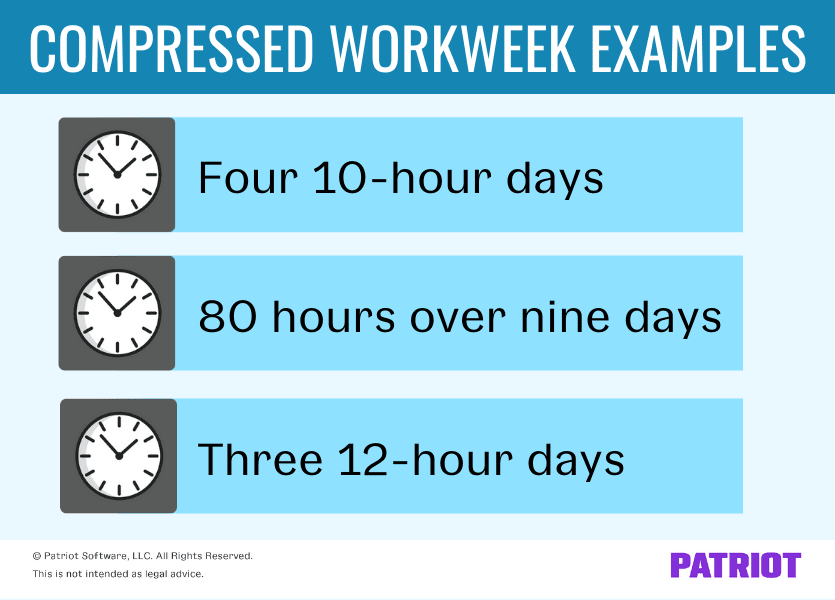As an employer, you may decide to experiment with flexible work schedules to boost productivity, combat turnover, and improve work-life balance. One type of flexible work arrangement you can try out is a compressed workweek. But, how does a compressed week work, and what’re the perks of having one in your business?
What is a compressed workweek?
Compressed workweeks allow employees to work a traditional 40-hour week in fewer than five workdays. This gives employees more time off per week to pursue personal obligations and interests, like spending time with family or going to a doctor’s appointment.
For a compressed workweek schedule, employees need to work longer days to accomplish the full number of required weekly hours (e.g., 40 hours per week). Compressed workweek examples include:
- Four 10-hour days and having three days off per week
- 80 hours over nine days and having a three-day weekend every other week
- Three 12-hour days and having four days off per week
Compressed hours work best for biweekly employees. However, it’s possible for employees with other pay frequencies (e.g., monthly) to utilize this flexible work schedule.

Compressed workweek advantages and disadvantages
Compressed schedules come with pros and cons. Check out a few perks and downsides of allowing employees to have a compressed workweek.
Some benefits of compressed workweek include:
- Higher productivity
- Better work-life balance
- Extended coverage per day
- Lower overhead costs
On the other hand, here are some disadvantages of compressed work schedules:
- Understaffing
- Not suited for all positions
- Can be physically or mentally draining for employees
- Can be complex with overtime
Before establishing a compressed work policy at your business, consider if it’s the best flexible work arrangement for your team. If you don’t think it’s a good fit, you can try other options, like remote work, flex time, or job sharing.
Compressed workweek and overtime rules
Compressed workweeks may seem like a good idea, until you throw overtime into the mix. Then, things can get a little complicated.
Compressed workweeks can be difficult for nonexempt employees who are eligible for overtime under FLSA (Fair Labor Standards Act) guidelines. As a brief recap, you must pay nonexempt employees overtime (1.5 times regular rate of pay) for any hours worked above 40 per week. Exempt employees are not covered under the FLSA, and therefore, cannot receive overtime. A nonexempt employee:
- Receives hourly wages
- Earns below the exempt threshold of $35,568 annually (or $684 per week)
- Does not have executive, administrative, or professional job duties
Additionally, some states have even stricter overtime rules. For example, nonexempt employees in California must receive overtime pay if they work beyond eight hours in a workday (up to 12 hours).
When a nonexempt employee who follows a compressed workweek schedule works overtime, you may have some added employer responsibilities. For example, if a nonexempt employee with a compressed workweek works 80 hour in nine days, there is one out of the two weeks they will work 45 hours (9 hours X 5 days). This means the employee will work five overtime hours during the one week even though they are splitting their 80 hours over two weeks.
So, how do you handle overtime for nonexempt employees with compressed hours? Depending on your state overtime rules, you may have no choice but to pay overtime to employees with compressed schedules.
If you want to start a compressed workweek at your business and ensure you stay compliant with overtime rules, you can also consider:
- Scheduling four 10-hour days per week
- This ensures nonexempt employees don’t work more than 40 hours a week.
- Adjusting your “defined workweek” (this may not help with daily overtime requirements set by the state)
- The FLSA only defines a workweek as a fixed and recurring period of 168 hours composed of seven consecutive 24-hour periods.
- For example, say employees are working four nine-hour days Monday – Thursday. You could have your workweek be from Friday at 12 PM – the following Friday at 12 PM, making it so employees only work 40 hours by noon on Friday.
Whatever route you decide to take, make sure you follow federal and state-specific overtime rules, maintain complete records of all hours worked, and pay overtime accordingly.
Creating a compressed workweek policy
Decided to give a compressed workweek the old college try? Great! To get your new flexible work arrangement up and running, you need to create a policy. Include the following in your policy:
- The type of compressed week (e.g., 10-hour work day)
- Eligible employees (e.g., exempt employees only)
- Hours employees must work (e.g., anytime between 6 AM – 7 PM)
- How employees can participate or opt-out
- Other compressed workweek rules
Once you establish your policy, let eligible employees know about it. Consider having participating employees sign a document stating they will follow the compressed workweek requirements. If an employee opts out, have them sign paperwork, too. Keep any signed forms in your payroll records for safekeeping.
Along with establishing your policy, make sure you have an easy and reliable way to track employee hours and overtime. Consider investing in time and attendance software to make tracking compressed hours easier for you and your employees.
This article has been updated from its original publication date of August 8, 2012.
This is not intended as legal advice; for more information, please click here.

